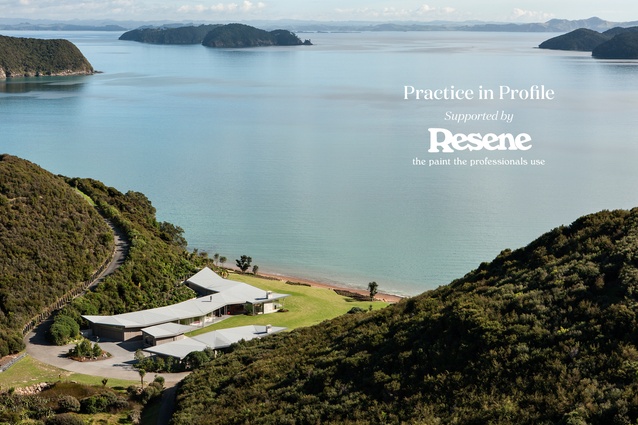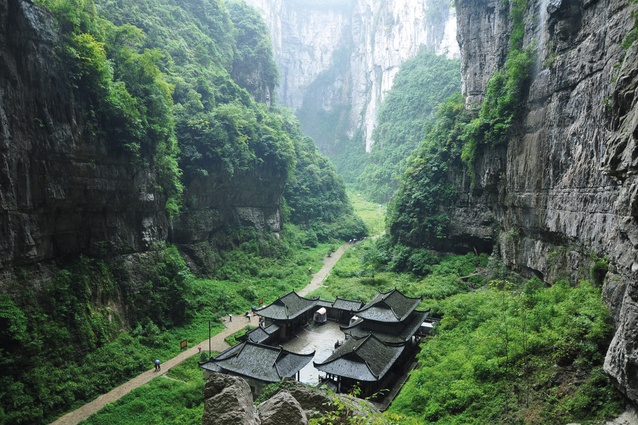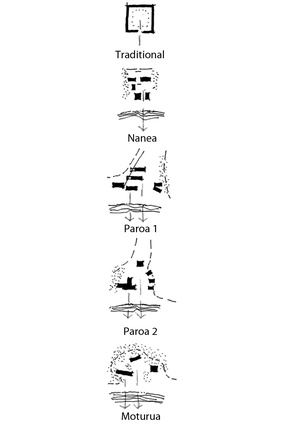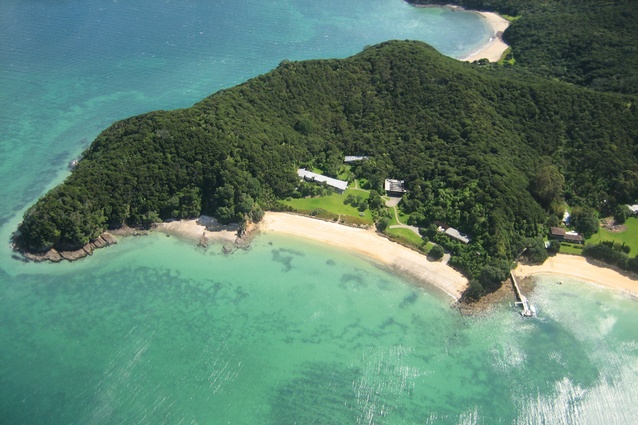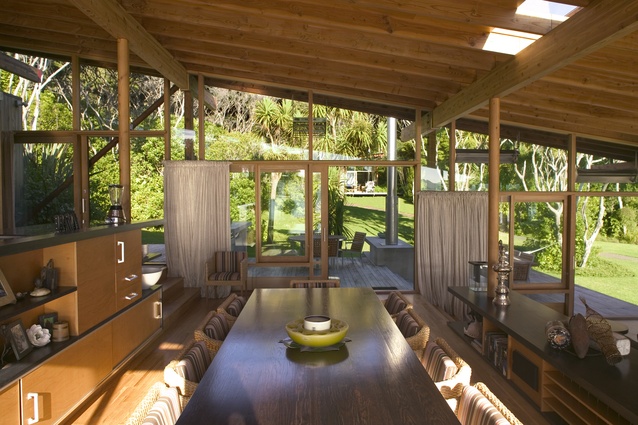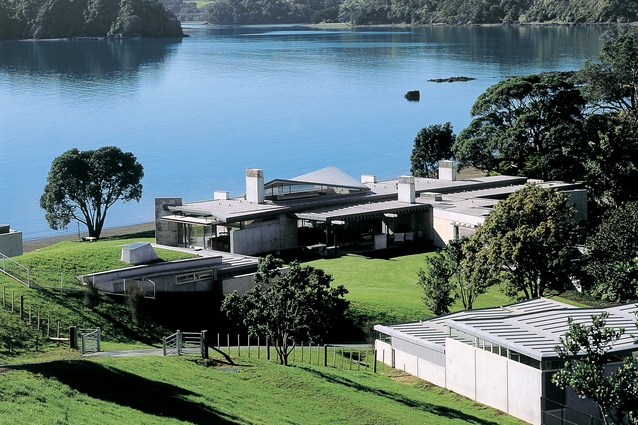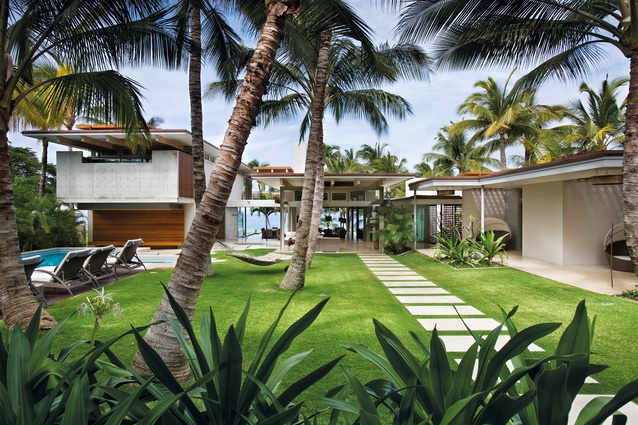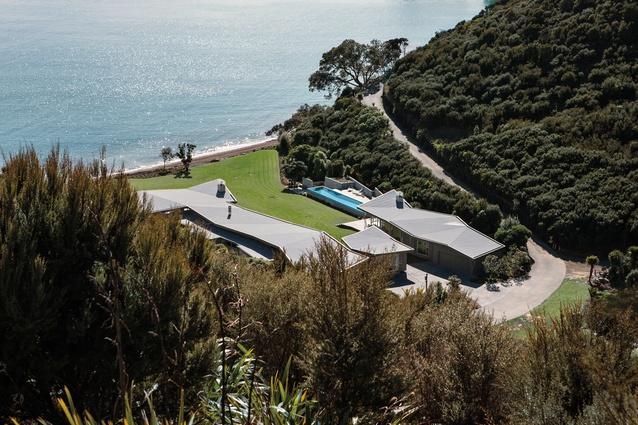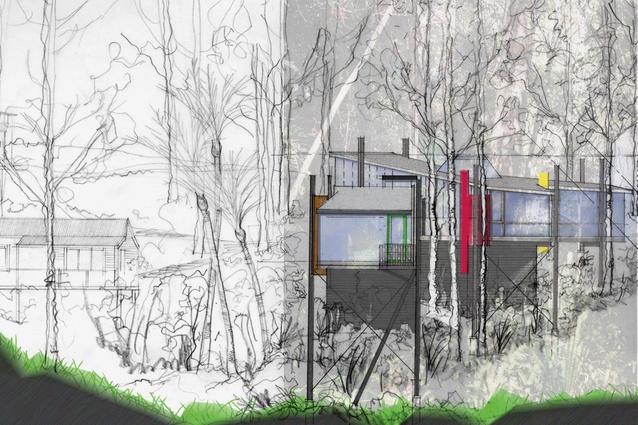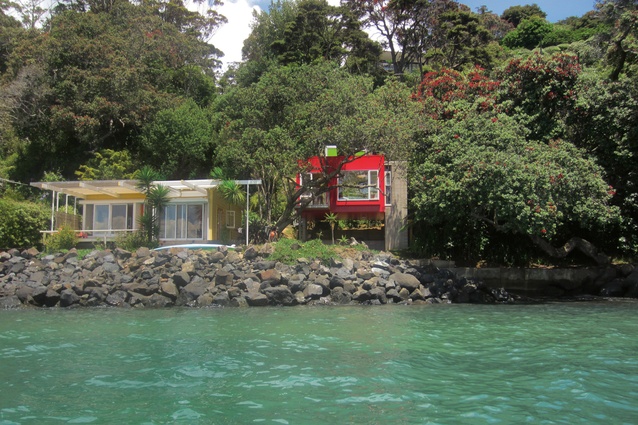From court to camp
Pete Bossley reflects on a recurring theme in his design practice.
Comments by the late David Mitchell were always worth listening to, and usually worth remembering. For me, one of the most notable was his quoting of Vernon Brown, who fulminated that good architecture is driven by a ‘red-blooded idea’.
This compelling notion has intrigued me for years and led to more fascinating questions, such as where do the ideas come from? From within architecture, is it from re-interpretations of existing architectural canons? Or, from outside architecture, is it as intuitive leaps of faith inspired by almost anything? A shape, a colour, a flash of insights that are developed later in a building form?
During my 40 years of practice, there has been ample opportunity to explore different ideas as generators of architecture. Many of the ideas we have developed can be grouped into themes. Interest in the peril inherent in New Zealand’s geology, alive with volcanoes and earthquakes, has led to ‘faulted’ buildings (as seen in the Heatley 1 House, Te Papa and Emirali House) where plans are disrupted by fault lines or dislocations. Enthusiasm for our wonderfully fluid skyscapes has inspired multiple ways of inviting natural light in to spaces (as seen in the Arruba House, the Kerr House light stalks and Paroa Bay’s paraboloid and oculus).
But the focus here is on one of the most recurring themes – the pursuit of a Kiwi form of encampment.
Our practice has repeatedly explored the possibility of a house as an encampment of internal and external spaces. The enthusiasm for this idea springs from the nostalgic notion of camping as something inherent in the New Zealand cultural psyche: a notion which probably has as much veracity as that other great myth that places the archetypal Kiwi bach at the centre of our shared childhoods. But the veracity of an idea has always seemed less important to me than is the concept it generates. In architectural terms, there is a much longer history at play than that of childhood notions of camping holidays.
Walled gardens, courtyard houses, encampments
We have attempted to develop a New Zealand version of the archetypal walled garden and courtyard house. These two, whilst often different in context, have much in common, and have been central in the architectural expression of Persian, Roman, Chinese, Indian, Spanish, South American and many other cultures.
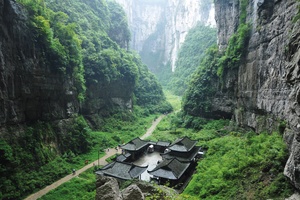
Vitruvius, in the Sixth Book of his Treatise, analysed examples of courtyard houses and, subsequently, Alberti, Vignola and Palladio applied his principles to their designs. Mediaeval Spanish traditions reveal incredibly rich variations on the courtyard house, which later migrated to the Central and South Americas.
In Persian history, the walled garden has great significance. Symbolically, the inner open space was described as Paradise: a safe and secure area sheltered from the terrors of the world outside. It had a more physical than religious meaning. In old Iranian languages, the noun pairidaēza, ‘a wall enclosing a garden or orchard’, was composed of pairi, ‘around’, and daēza, ‘wall’. Pairi later became the Greek form peri, as in perimeter. Daēza comes from the Indo-European root *dheigh, ‘to mould, form, shape’. This led to the Greek word ‘paradeisos’, which referred to the walled gardens of Persia: places of exquisite beauty and abundance. In biblical times, the word transmuted to the heavenly gardens of Eden and, slowly, the modern meaning of Paradise emerged.1
Central is the desire to create a sheltered world, secure from exterior chaos. It was desirable to exclude the outer world, be it a natural or an urban one, whilst also creating a focus for family life. Whether for defence or symbolic purposes, the security and peace offered by the walled garden or courtyard was a powerful and undeniable generator of form.
Encampments developed from different roots. The term refers to everything from the casual gathering of a few tents to the rigidly organised military structures which the Romans perfected; their defensive perimeters were similar to those of the walled gardens, and there was an orthogonal formality to the layout of tents.
One can also read the marae composition as a form of encampment: an encampment with purpose, with the wharenui, wharekai and others gathered to create the ātea space, often reinforced by hedges, fences and planting. As the research of Mike Austin and others has indicated, the sites are often selected so there are associated landscape features reinforcing the form and creating a backdrop which adds power to the directional openness of the ātea. In Austin’s terms, the marae is a “restatement of the landscape”.2 A walled garden without walls.
Modern architects have explored the implications of walled gardens and encampments. Aalto’s beautiful holiday retreat in Muuratsalo incorporates an almost-completed formal enclosure as well as a casual encampment composition.
From walled garden/courtyard house to encampment
It seemed to us that a Kiwi version of a walled garden would reflect the attributes of a landscape-oriented culture. Openness is a basic element of our settlement patterns and New Zealanders seem to be comfortable with this openness. It is demonstrated by our love of transitional spaces, so that most of our settlements are located between sea and mountain, or our stubborn insistence on suburban life rather than a more-dense urban option.
What would a Kiwi encampment look like? Given the comfort with openness and the associated transitional conditions, a New Zealand version might be suggestive where the traditional is clear and certain; it might be speculative instead of definite, informal rather than formal. It would be inclusive rather than exclusive.
Over many projects, we have incorporated the qualities and contours of the existing landscape to become active contributors to the elements of enclosure so that the buildings and the landform are acting as one.
The solidity of the walled garden becomes more ephemeral. The space leaks through between the buildings then is caught by the second tier: the landform behind. Paradoxically, the land seeps in towards the centre space, accepted as a contributor, rather than feared as a symbol of exterior, unknown chaos. The New Zealand enthusiasm for openness is accommodated as is a more relaxed approach to building form.
As always, there is a balancing act between the degrees to which openness can be incorporated without destroying the desired level of enclosure. Each site and each gathering of buildings requires its own scrutiny and series of intuitive selections to attain the appropriate sense of poise. What degree of enclosure is required? What proportion of mass versus space? What does the existing landform suggest? What does the programmatic brief call for? How can the addition of buildings to a beautiful situation ennoble the already-extant poetics of the space?
Such compositions of buildings, landscape and space provide frequent pleasures, offering large and small axes, long and short vistas, scale changes, intensities and release points. The Greeks coined the term parallax to explain such phenomena, Steven Holl borrowed it, video gamers develop it to emphasise 3D movement in 2D, and it applies here, as one moves through the compositions with the landscape rolling behind the foreground buildings.
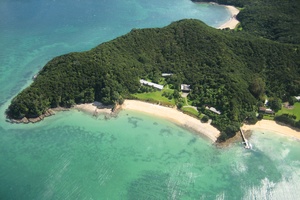
Moturua: A delicate balance
Above all, the Moturua house is an exercise in exploring the delicate balances possible in architecture. The main house and guest house negotiate issues to do with enclosure and comfort; what are the minimum elements of mass one can provide, in conjunction with the adjacent trees, and still provide comfort and enclosure? How thin can the columns be? How light can the roof feel? What is the balance between the openness through the linear house and the security gained from the roof floating above?
The spaces between the buildings are critical. Much time was spent exploring the separations and the degrees of privacy created by distance and by the occasional clumps of trees. Three buildings create the main encampment: the house, the guest house and the helicopter shed, which doubles as a games room, with rumpus room and sleeping accommodation slung off to the side. Further away, along the beach, the caretaker’s cottage sits above an underground boatshed.
The buildings reinforce the landscape, and the topography, reinforced by additional vegetation, buttresses the buildings. The buildings suggest contained space, initially, or it leaks back to be enclosed by the second layer of enclosure, the hills beyond.
The main house and guest house step up the slopes in half-metre rises, respecting the contours and providing natural ventilation encouraged by warm air rising under the slope of the roof, and cross-ventilation traversing the linear plan. Large overhangs limit solar gains.
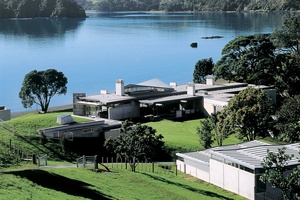
Paroa Bay House
The beachfront site for the Paroa Bay House was a complex intersection of competing forces: a valley funnels the sou’west wind down from behind, a small stream compresses the buildable site, a driveway continues across the site to the neighbour’s house and a steep bank with loose geotechnical character bounds the western flank.
The encampment approach allowed us to reinforce the dominant landscape, and reduce the visual impact of a large house, which comprises the main dwelling, three sleepouts, and a garage utility shed for the equipment and machinery used to run the farm.
Generosity dominated the client’s brief. The main house has a large covered terrace on the landward side, sheltered from the north-east breezes off the sea. Three sleepouts, tucked in to the rising topography, are arrayed around the focal terrace, which becomes the heart of family living. It houses a fireplace and over-scaled lounge seating, a long table and a barbecue. It is the heart and also a gesture of generosity as it is the initial arrival point. There is no front door; guests are greeted by welcoming hospitality.
As is often the case with our houses, there is an alternative terrace, this time to the north, enabling outdoor living to continue when the opposite prevailing wind from the south comes down the valley.
A limited and earthy palette of in-situ concrete, steel and honey-coloured blocks is combined with timber used judiciously to add warmth. Above the living room hovers a hyperbolic paraboloid roof, lifted in diagonally opposing corners to encourage morning and evening light to enter the space below.
The pasture of the farmed hillside runs down between the sleepouts into the central space, while the roofs have long grass or pasture to nestle the buildings further in to the land.
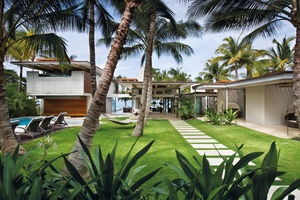
Nanea
Of all the encampment projects, the Nanea House in Maui has the least landform contribution. The neighbours are suburban houses and so the openness is controlled to the sides by planting and is more predominantly directed towards the sea. In the Hawaiian climate, the space between buildings becomes invaluable for encouraging breezes to cool the air, softened by screens for visual privacy. Wide overhangs connect the buildings and provide shelter from the sun.
The neighbouring sites have swimming pools facing the beach whereas, here, the pool is located within the courtyard, away from the trade winds that disturb the beachfronts every afternoon. The central courtyard softly leaks space between the living areas towards the sea and through the living wing itself, by virtue of the transparency of the walls. Even back in the courtyard, one is always aware of the presence of the sea, which, after all, is the motivation for being there in the first place.
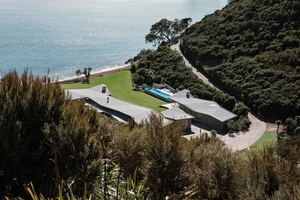
Fold House
On a relatively tight, steep-sided valley in the Bay of Islands, we developed a tri-partite scheme of buildings, overlaid with folded planes like gently fallen leaves. Whereas the rooms have their own geometries, the roof follows independent alignments. Sometimes, the two share structure; at other times, the roof has its own.
The deep bay formed between the three elements of the Fold House reinforces the natural bay of the beach and the contours either side of the house, creating a bay within a bay, whilst still opening up to the long direction of the valley behind. As a result, all the rooms have different connections to the sea and areas between the elements, offering a new range of experiences from each space.
McCahon Artists’ Retreat
Colin McCahon and his family lived in French Bay during the 1950s and, there, he painted some of his most iconic paintings. For an artists’ retreat adjacent to the family cottage and garage/sleepout, we took the opportunity to thread two more buildings between the trees, which together combine with the existing buildings and the enveloping forest to create an encampment, which supports the original small cottage without overpowering it.
The deck, which links the two new buildings, becomes a centre of life for the occupants – artists who stay for three months – in such a way that the cottage is present and the inspiration of the McCahon reputation is present but not daunting.
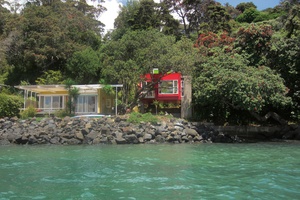
Arruba
The pair of buildings of the Arruba House forms a composition incorporating pōhutukawa, the cliffs behind and a third built element: a deck nestled up the hillside, which relates more to campsites than to walled gardens. But the atmosphere of the encampment, where passage between the buildings keeps one in touch with the elements and provides shifting vistas to the sea, remains a key generator of the form.
As a footnote to thoughts about encampments, I was recently asked by my granddaughter to talk to her primary school class about model-making, to assist in a project they were preparing. Whilst showing them the Arruba model, I asked if they had all been camping and was pleasantly surprised to hear they all had. I described these little buildings as relating to camping, and the need to pass between them in the rain, getting wet or experiencing the stars at night. One kid enthusiastically raised his hand and called: “Pete, Pete, it is more like glamping, isn’t it?” Indeed, it is.
Pete Bossley is Director of Bossley Architects, a 20-person practice in Auckland, and was the 2012 recipient of the NZIA Gold Medal; he has recently written One Year Drawn, a book of sketches and observations, due to be published in September 2019.
1 Paradise, The City as Project. thecityasaproject.org/2011/07/paradise/
2 Austin, M. A., description of the Māori marae (1976), cited in Jenkins, D. L. (ed.) (2005). New Dreamland: Writing New Zealand Architecture. Auckland: Random House New Zealand,
pp. 222–235.

